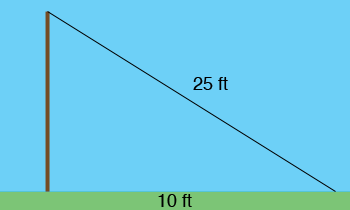| |||
| Math Central | Quandaries & Queries |
|
Question from Michael: If a 25 foot cable is attached to the top of a pole, and that cable attaches to the ground ten feet away from that pole, how tall is the pole? The 25 foot cable is the hypotenuse of a right triangle with a base of ten feet. |
We have two responses for you
Michael,
First draw a diagram

Then go to the Quandaries and Queries page on Math Central and Use the Quick Search to search for the word Pythagoras. You will see many applications of Pythagoras' Theorem to solve such problems.
Penny
Hi Michael,
In every right triangle, the square of the hypotenuse is always equal to the sum of the squares of the other two sides. This is known as the Pythagorean Theorem and you may have seen it written as:
c^2 = a^2 + b^2
When written in that form, c = length of the hypotenuse
a = length of one of the sides
b = length of the third side
In your question, c = 25, and a = 10. You must solve for b:
25^2 = 10^2 + b^2
625 = 100 + b^2
525 = b^2
At this point we must take the square root of both sides of the equation, keeping only the positive square root and rejecting the negative square root (as length can not be negative).
Therefore b = sqrt(525) = 22.913 (rounded to the nearest thousandth).
Hope this helps,
Leeanne
 |
||
Math Central is supported by the University of Regina and The Pacific Institute for the Mathematical Sciences.